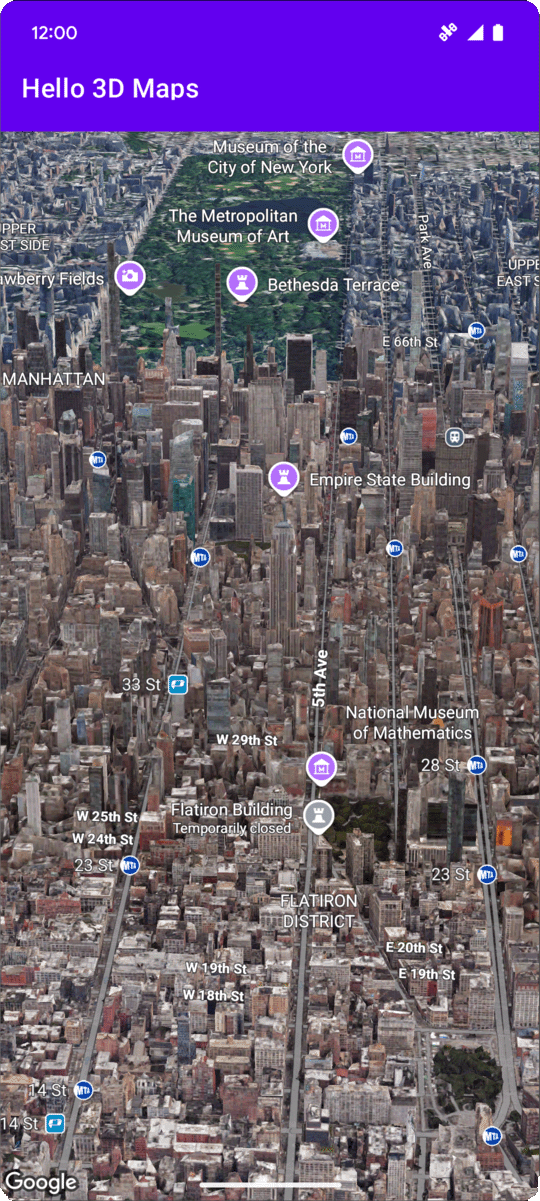
Halaman ini membahas contoh cara menambahkan peta 3D dasar ke aplikasi Android menggunakan Maps 3D SDK for Android. Petunjuk di halaman ini mengasumsikan bahwa Anda telah menyelesaikan langkah-langkah di halaman Penyiapan dan memiliki hal berikut:
- Project Google Cloud dengan Maps 3D SDK for Android diaktifkan
- Kunci API yang dikonfigurasi untuk digunakan dengan Maps 3D SDK for Android
- Project Android Studio yang disiapkan untuk digunakan dengan Maps 3D SDK for Android
Untuk mengetahui informasi selengkapnya tentang prasyarat ini, lihat Penyiapan.
Bagian 1: Perbarui File Tata Letak (activity_main.xml) untuk menambahkan komponen Map3DView
Komponen Map3DView adalah tampilan yang merender peta 3D dalam aplikasi.
Langkah-langkah berikut menambahkan komponen dan mengonfigurasi status awal
peta, termasuk posisi kamera dan atribut terkait:
Buka file tata letak aktivitas utama Anda, yang biasanya terletak di
app/src/main/res/layout/activity_main.xml.Di
ConstraintLayoutroot (atau elemen tata letak root), tambahkan namespace XMLmap3d:xmlns:map3d="http://schemas.android.com/apk/res-auto"Hapus
<TextView>default yang menampilkan "Hello World!".Tambahkan komponen
Map3DViewke tata letak Anda. Anda dapat menyesuaikan posisi kamera dan atribut lainnya:<?xml version="1.0" encoding="utf-8"?> <androidx.constraintlayout.widget.ConstraintLayout xmlns:android="http://schemas.android.com/apk/res/android" xmlns:app="http://schemas.android.com/apk/res-auto" xmlns:map3d="http://schemas.android.com/apk/res-auto" xmlns:tools="http://schemas.android.com/tools" android:id="@+id/main" android:layout_width="match_parent" android:layout_height="match_parent" tools:context=".MainActivity"> <com.google.android.gms.maps3d.Map3DView android:id="@+id/map3dView" android:layout_width="match_parent" android:layout_height="match_parent" map3d:mode="hybrid" map3d:centerLat="38.544012" map3d:centerLng="-107.670428" map3d:centerAlt="2427.6" map3d:heading="310" map3d:tilt="63" map3d:range="8266" map3d:roll="0" map3d:minAltitude="0" map3d:maxAltitude="1000000" map3d:minHeading="0" map3d:maxHeading="360" map3d:minTilt="0" map3d:maxTilt="90" app:layout_constraintBottom_toBottomOf="parent" app:layout_constraintEnd_toEndOf="parent" app:layout_constraintStart_toStartOf="parent" app:layout_constraintTop_toTopOf="parent" /> </androidx.constraintlayout.widget.ConstraintLayout>
Bagian 2: Update MainActivity.kt
Langkah-langkah berikut menginisialisasi komponen Map3DView yang ditambahkan ke file
activity_main.xml di Bagian 1 dan mengelola peristiwa siklus proses komponen:
Buka file
MainActivity.ktAnda, yang biasanya terletak diapp/src/main/java/com/example/yourpackagename/MainActivity.kt.Tambahkan impor yang diperlukan untuk Maps 3D SDK for Android:
import com.google.android.gms.maps3d.GoogleMap3D import com.google.android.gms.maps3d.Map3DView import com.google.android.gms.maps3d.OnMap3DViewReadyCallbackUbah class
MainActivityuntuk menerapkanOnMap3DViewReadyCallback:class MainActivity : AppCompatActivity(), OnMap3DViewReadyCallback {Deklarasikan variabel untuk
Map3DViewdanGoogleMap3D:private lateinit var map3DView: Map3DView private var googleMap3D: GoogleMap3D? = nullDalam metode
onCreate, setelahsetContentView(...)dan blokViewCompat.setOnApplyWindowInsetsListener, lakukan inisialisasimap3DView, panggil metode siklus prosesonCreate, dan minta peta secara asinkron:override fun onCreate(savedInstanceState: Bundle?) { super.onCreate(savedInstanceState) enableEdgeToEdge() setContentView(R.layout.activity_main) ViewCompat.setOnApplyWindowInsetsListener(findViewById(R.id.main)) { v, insets -> val systemBars = insets.getInsets(WindowInsetsCompat.Type.systemBars()) v.setPadding(systemBars.left, systemBars.top, systemBars.right, systemBars.bottom) insets } map3DView = findViewById(R.id.map3dView) map3DView.onCreate(savedInstanceState) map3DView.getMap3DViewAsync(this) }Ganti metode
onMap3DViewReady. Callback ini dipicu saat peta siap digunakan:override fun onMap3DViewReady(googleMap3D: GoogleMap3D) { // Interact with the googleMap3D object here this.googleMap3D = googleMap3D // You can now make calls to the googleMap3D object, e.g., // googleMap3D.cameraController.flyTo(camera { ... }) }Teruskan peristiwa siklus proses dari Aktivitas Anda ke
Map3DViewdengan menambahkan penggantian berikut keMainActivity:override fun onStart() { super.onStart() map3DView.onStart() } override fun onResume() { super.onResume() map3DView.onResume() } override fun onPause() { map3DView.onPause() super.onPause() } override fun onStop() { map3DView.onStop() super.onStop() } override fun onDestroy() { map3DView.onDestroy() super.onDestroy() } override fun onSaveInstanceState(outState: Bundle) { super.onSaveInstanceState(outState) map3DView.onSaveInstanceState(outState) } override fun onLowMemory() { super.onLowMemory() map3DView.onLowMemory() }
Bagian 3: Sinkronkan Gradle dan Jalankan
Setelah memperbarui tata letak dan aktivitas aplikasi, Anda dapat membangun dan menjalankan aplikasi untuk melihat tampilan peta 3D.
Untuk menyinkronkan proyek Anda dengan Gradle, pilih File > Sinkronkan Proyek dengan File Gradle.
Untuk membuat dan menjalankan aplikasi di emulator atau perangkat fisik, pilih Run > Run.
Jika semuanya dikonfigurasi dengan benar, Anda akan melihat peta 3D yang ditampilkan di aplikasi Anda, yang berpusat di dekat koordinat yang ditentukan di activity_main.xml Anda.
Langkah berikutnya
Setelah menambahkan peta 3D dasar ke aplikasi, Anda dapat menjelajahi fitur lanjutan Maps 3D SDK for Android, seperti animasi jalur kamera, penanda 3D, atau poligon.

